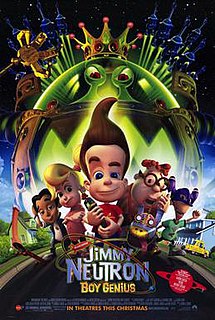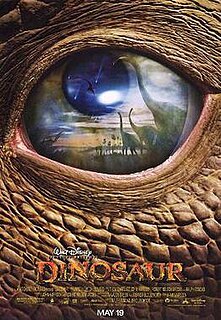
Computer animation is the process used for digitally generating animated images. The more general term computer-generated imagery (CGI) encompasses both static scenes and dynamic images, while computer animation only refers to moving images. Modern computer animation usually uses 3D computer graphics to generate a three-dimensional picture. Sometimes, the target of the animation is the computer itself, but sometimes film as well.

Clay animation or claymation, sometimes plasticine animation, is one of many forms of stop-motion animation. Each animated piece, either character or background, is "deformable"—made of a malleable substance, usually plasticine clay.

Traditional animation is an animation technique in which each frame is drawn by hand. The technique was the dominant form of animation in cinema until computer animation.

Jimmy Neutron: Boy Genius is a 2001 American computer-animated science fiction comedy film produced by Nickelodeon Movies, O Entertainment and DNA Productions, and distributed by Paramount Pictures. The film was directed by John A. Davis and written by Davis and producer Steve Oedekerk. Its voice cast includes Debi Derryberry, Patrick Stewart, Martin Short, Rob Paulsen, and Jeffrey Garcia. The film follows the title character, a schoolboy with super-genius intelligence, who must save all of the parents of his hometown from a race of egg-like aliens known as the Yolkians.

Dinosaur is a 2000 American live-action/computer-animated adventure film produced by Walt Disney Feature Animation in collaboration with The Secret Lab. The 39th Disney animated feature film, it follows a young Iguanodon who was adopted and raised by a family of lemurs on a tropical island. After surviving a devastating meteor shower, the family move out for their new home and befriend a herd of dinosaurs along the way while on a journey to the "Nesting Grounds". Unfortunately, they are being hunted down by predators such as Carnotaurus.

Skeletal animation or rigging is a technique in computer animation in which a character is represented in two parts: a surface representation used to draw the character and a hierarchical set of interconnected parts, a virtual armature used to animate the mesh. While this technique is often used to animate humans and other organic figures, it only serves to make the animation process more intuitive, and the same technique can be used to control the deformation of any object—such as a door, a spoon, a building, or a galaxy. When the animated object is more general than, for example, a humanoid character, the set of "bones" may not be hierarchical or interconnected, but simply represent a higher-level description of the motion of the part of mesh it is influencing.

Red's Dream is a 1987 American computer-animated short film produced by Pixar and directed by John Lasseter. The short film, which runs four minutes, stars Red, a unicycle. Propped up in the corner of a bicycle store on a rainy night, Red dreams of a fantasy where it becomes the star of a circus. Red's Dream was Pixar's second computer-animated short following Luxo Jr. in 1986, also directed by Lasseter.
Sculpt 3D is a raytrace application released in 1987 for Amiga computers programmed by Eric Graham. Sculpt 3D was one of the first ray tracing applications released for the Amiga computers. It proved that raytracing could be done on home computers as well as on mainframes. Years later, the company Byte by Byte released a port for the Apple Macintosh.
Computer facial animation is primarily an area of computer graphics that encapsulates methods and techniques for generating and animating images or models of a character face. The character can be a human, a humanoid, an animal, a legendary creature or character, etc. Due to its subject and output type, it is also related to many other scientific and artistic fields from psychology to traditional animation. The importance of human faces in verbal and non-verbal communication and advances in computer graphics hardware and software have caused considerable scientific, technological, and artistic interests in computer facial animation.
Information International, Inc., commonly referred to as Triple-I or III, was an early computer technology company.

A virtual human, virtual persona, or digital clone is the creation or re-creation of a human being in image and voice using computer-generated imagery and sound, that is often indistinguishable from the real actor.
The history of computer animation began as early as the 1940s and 1950s, when people began to experiment with computer graphics – most notably by John Whitney. It was only by the early 1960s when digital computers had become widely established, that new avenues for innovative computer graphics blossomed. Initially, uses were mainly for scientific, engineering and other research purposes, but artistic experimentation began to make its appearance by the mid-1960s – most notably by Dr Thomas Calvert. By the mid-1970s, many such efforts were beginning to enter into public media. Much computer graphics at this time involved 2-dimensional imagery, though increasingly as computer power improved, efforts to achieve 3-dimensional realism became the emphasis. By the late 1980s, photo-realistic 3D was beginning to appear in film movies, and by mid-1990s had developed to the point where 3D animation could be used for entire feature film production.

Computer-generated imagery (CGI) is the application of computer graphics to create or contribute to images in art, printed media, video games, simulators, computer animation and VFX in films, television programs, shorts, commercials, and videos. The images may be dynamic or static, and may be two-dimensional (2D), although the term "CGI" is most commonly used to refer to the 3-D computer graphics used for creating characters, scenes and special effects in films and television, which is described as "CGI animation".

Nadia Magnenat Thalmann is a computer graphics scientist and robotician and is the founder and head of MIRALab at the University of Geneva. She has chaired the Institute for Media Innovation at Nanyang Technological University (NTU), Singapore from 2009 to 2021.

Prof. Daniel Thalmann is a Swiss and Canadian computer scientist and a pioneer in Virtual humans. He is currently Honorary Professor at EPFL, Switzerland and Director of Research Development at MIRALab Sarl in Geneva, Switzerland.

Spider-Man: Into the Spider-Verse is a 2018 American computer-animated superhero film featuring the Marvel Comics character Miles Morales / Spider-Man, produced by Columbia Pictures and Sony Pictures Animation in association with Marvel Entertainment. Distributed by Sony Pictures Releasing, it is the first animated film in the Spider-Man franchise. Directed by Bob Persichetti, Peter Ramsey, and Rodney Rothman from a screenplay by Phil Lord and Rothman, it stars Shameik Moore as Morales, alongside the voices of Jake Johnson, Hailee Steinfeld, Mahershala Ali, Brian Tyree Henry, Lily Tomlin, Luna Lauren Vélez, John Mulaney, Kimiko Glenn, Nicolas Cage, and Liev Schreiber. The film's story follows Miles Morales as he becomes the new Spider-Man and joins other Spider-People from various parallel universes to save his universe from Kingpin.

Michael Kass is an American computer scientist best known for his work in computer graphics and computer vision. He has won an Academy Award and the SIGGRAPH Computer Graphics Achievement Award and is an ACM Fellow.

Spider-Man: Across the Spider-Verse is an upcoming American computer-animated superhero film featuring the Marvel Comics character Miles Morales / Spider-Man, produced by Columbia Pictures and Sony Pictures Animation in association with Marvel, and distributed by Sony Pictures Releasing. It is the first of a two-part sequel to Spider-Man: Into the Spider-Verse (2018) and is set in a shared multiverse of alternate universes called the "Spider-Verse". The film is directed by Joaquim Dos Santos, Kemp Powers, and Justin K. Thompson from a screenplay by Phil Lord, Christopher Miller, and David Callaham. Shameik Moore voices Morales, starring alongside Oscar Isaac, Hailee Steinfeld, Jake Johnson, and Issa Rae.
Virtual humans are simulations of human beings on computers. The research domain is concerned with their representation, movement and behavior. There is a wide range of applications: simulation, games, film and TV productions, human factors and ergonomic and usability studies in various industries, clothing industry, telecommunications (avatars), medicine, etc. These applications require different know-hows. A medical application might require an exact simulation of specific internal organs; film industry requires highest aesthetic standards, natural movements, and facial expressions; ergonomic studies require faithful body proportions for a particular population segment and realistic locomotion with constraints, etc. The merging














